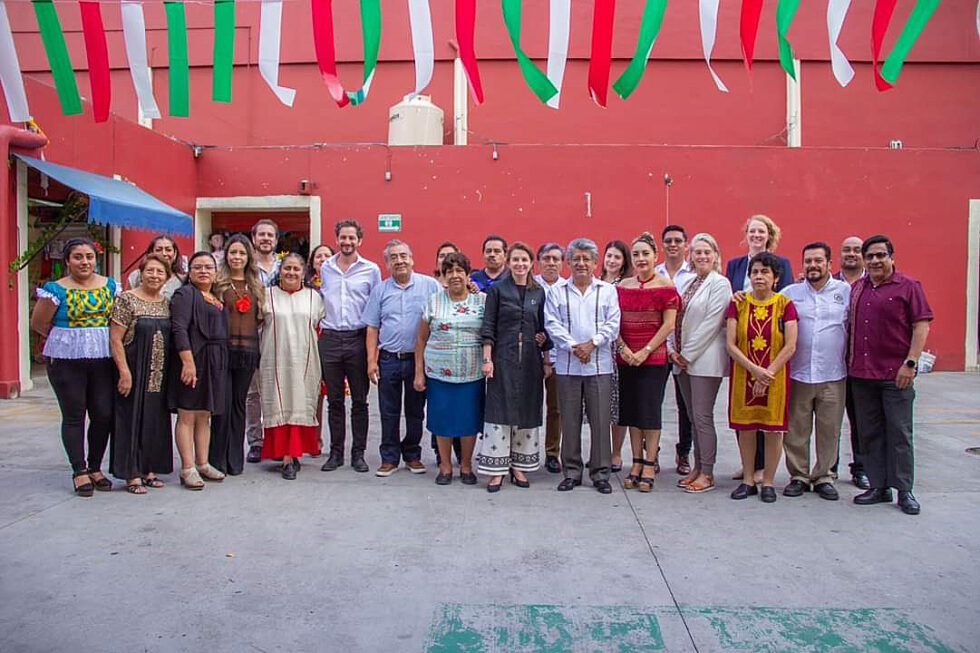INNOVATION IN PROGRESS: CALZADA DEL AGUA’S RESULTS REVEALED
“The key to a successful project? Working in a participatory way.” Calzada del Agua has addressed water security challenges in the Mexican City of Oaxaca with innovative spatial planning and BlueBloqs technology. Their feasibility study, funded by Partners for Water, has been successfully finalized. Below, consortium partner Adrian Puentes elaborates on the study's conclusion, the project’s impact and the next steps to come.
Mexico faces the challenge of managing both floods and droughts. To address this issues, Adrian Puentes, Architect and Urban Planner at BD+P, and consortium partners FieldFactors and Centro SC, introduced a circular water system featuring BlueBloqs technology. This approach enables the local collection, purification and underground storage of rainwater, and facilitates its reuse. Their feasibility study has now successfully come to an end. We spoke with Adrian about the outcomes, the impact and the next steps to come.

Outcomes of the feasibility study
“An important outcome of the feasibility study is that the traditional market square in we selected in the City of Oaxaca turns out the be the perfect location for a pilot of our circular water system. It has a high gap between water demand and availability, has great potential for creating social impact and the right physical conditions for technical and legal feasibility,” says Adrian enthusiastically. He continuous: “We encountered roadblocks due to legal regulations, but we customized our final technical proposal and managed to successfully create a promising business case.” Another outcome of the feasibility study was the development of an urban toolbox by Adrian and his team. This tool helps in the decision-making process for selecting urban spaces where their BlueBloqs solution can be applied.

Local impact
“Apart from naturally recharging the area’s aquafer, the project has also a social impact on the local people,” Adrian says. He explains: “The locals working in the market have formed various factions. Before the start of the project, they often clashed over different views on managing the market square. However, the project has united them with a strong, collective desire for its success.” Their collective enthusiasm for the project comes from the fact that they often face water shortages which results in expensive water deliveries by truck. “Our solution projects to reduce their water expenses by 50% while ensuring a more reliable and consistent water supply,” explains Adrian.
Additionally, the square is set to undergo a transformation from a deteriorated, relatively unsafe area to an accessible, green space with comfortable seating, prominent water features and enhanced nighttime lighting. Adrian: “This will make it a safer and more inviting place."

Stakeholder involvement
“Working in a participatory way is the key to a successful project,” Adrian states. “From the beginning, we have involved many stakeholders. From the area’s residents to the water sector, heritage institutes and the municipality. Not only to involve them, but also to truly understand the people, the community and their relation to water.” Adrian explains that they incorporated this by conducting formal workshops and meetings, but also through informal ways, such as cycling around and socialising with the community. Adrian: “I think trying to be humble and aim to learn from the local community at first, and then incorporate these understandings into the solution makes an invaluable difference”.
The next steps
“With the positive results of the feasibility study, we are determined to move forward with the pilot project to proof the working of the system; technically as well as socially. Both the local people and the municipality of Oaxaca strongly support the project, so the next step is to secure funding for the pilot and develop the executive plan.” Adrian is very positive about the potential for the project to scale up. He says: “There are many squares like this in Oaxaca, and more than 100,000 markets in Mexico with similar water challenges and business cases. Many municipalities have expressed their interested in our collaboration already, so the future of our BlueBloqs solution looks promising.”
Innovation in progress series
During the Partners for Water programme 2022 – 2027, several projects that received the Partners for Water subsidy will be followed from start to finish. Over the next few years, they will take you with them on their transformative journey. You’ll be able to gain insights into their promising solutions, innovative processes and collaborations with local partners, as well as their struggles, challenges and valuable lessons learned. Stay tuned and follow their journey through the Partners for Water website and our LinkedIn page!